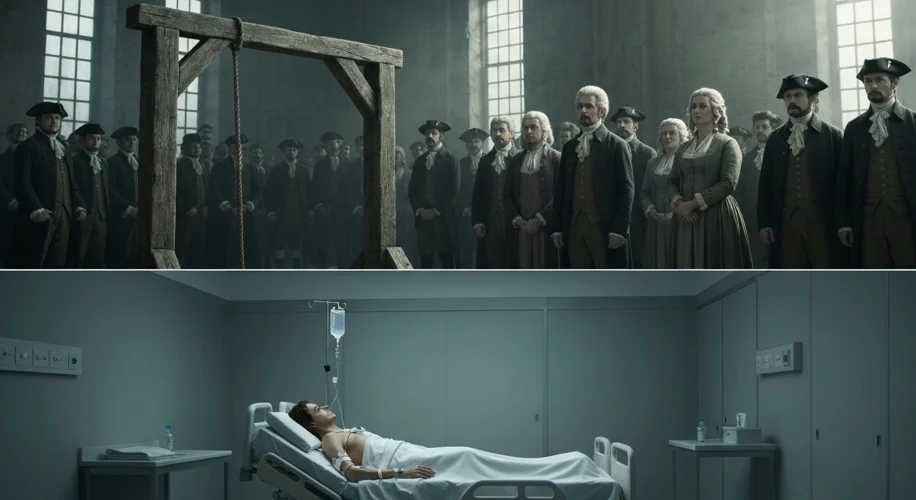From the gallows of colonial America to the sterile efficiency of the lethal injection table, the history of capital punishment in the United States is a grim and compelling narrative. It is a story etched in the nation’s legal codes, stained by societal anxieties, and forever debated in the courts of justice and public opinion.
When the first European settlers landed on American shores, they brought with them the familiar rituals of justice and punishment from their homelands. In England, hanging was the standard for a wide array of offenses, from petty theft to treason. This practice, along with other brutal methods like burning at the stake and the drawing and quartering of traitors, soon found its way into the fledgling colonies. Early American justice was swift, often public, and rarely forgiving. A crime could lead to a trial, and a guilty verdict for many offenses meant a date with the hangman.
The colonial era saw capital offenses listed extensively in statutes, often reflecting a society grappling with establishing order in a vast and often unforgiving wilderness. Theft, blasphemy, witchcraft, and murder were all grounds for the ultimate penalty. The public nature of executions served as a stark warning, a theatrical display of the state’s power and the consequences of transgression. Imagine the scene: a crowd gathered, a scaffold erected, a condemned soul facing their final moments, all under the watchful eyes of a community seeking to solidify its moral and legal boundaries.
As the nation grew and evolved, so too did its approach to capital punishment. The Enlightenment ideals of reason and a more humane justice began to take root, leading to a gradual reformist movement. States began to abolish the death penalty for certain crimes, and debates emerged about the fairness and efficacy of state-sanctioned killing. The 19th century witnessed a shift towards less gruesome methods, with hanging remaining prevalent but the more barbaric spectacles of earlier eras fading.

However, the 20th century brought new waves of change and controversy. The electric chair, introduced in the late 19th century, was hailed by some as a more modern and humane alternative to hanging. Yet, its early implementations were often plagued by gruesome failures, raising new questions about the ‘humane’ nature of execution. The gas chamber later emerged as another ‘scientific’ method, aiming for a swift and painless death, only to face its own set of ethical and practical challenges.
Throughout this period, key actors and perspectives shaped the legal and social landscape of capital punishment. Abolitionist movements gained momentum, arguing on moral, religious, and practical grounds that the state should not have the power to take a life. Conversely, proponents argued for its necessity as a deterrent, a just retribution for heinous crimes, and a means of ensuring public safety. Supreme Court cases, such as Furman v. Georgia (1972), which temporarily halted all executions nationwide, and Gregg v. Georgia (1976), which reinstated it under revised guidelines, became pivotal moments in this ongoing legal battle. These decisions reflected the nation’s deep divisions and its struggle to reconcile its founding principles with the practice of capital punishment.
The modern era has seen the widespread adoption of lethal injection, beginning in Oklahoma in 1977. Touted as the most humane method yet, it involves a cocktail of drugs designed to induce unconsciousness, paralysis, and finally, cardiac arrest. Yet, even this method has not been without its controversies, with botched executions and challenges to the drug protocols frequently making headlines.
The consequences and impact of capital punishment are profound and far-reaching. For the condemned, it represents the irreversible termination of life. For the victims’ families, it can be a source of closure, or a protracted and agonizing legal process. For society, it continues to be a focal point for discussions about justice, morality, and the role of the state. The data on its deterrent effect remains inconclusive, fueling arguments on both sides.
Analysis and interpretation of capital punishment in America reveal a complex interplay of historical context, cultural values, and legal evolution. It stands as a stark reminder of the state’s ultimate power over its citizens, and the enduring tension between retribution and rehabilitation. The debate over its morality and efficacy is not merely a legal one; it is a deeply philosophical and societal question that continues to resonate, reflecting the very soul of the nation.
As we look back, the trajectory of capital punishment in the U.S. is not a straight line but a winding path, marked by shifts in public sentiment, legal challenges, and the constant, uneasy negotiation of what constitutes justice.

